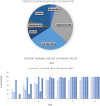Mechanisms of Transcranial Doppler Ultrasound phenotypes in paediatric cerebral malaria remain elusive
- PMID: 35729574
- PMCID: PMC9210743
- DOI: 10.1186/s12936-022-04163-0
Mechanisms of Transcranial Doppler Ultrasound phenotypes in paediatric cerebral malaria remain elusive
Abstract
Background: Cerebral malaria (CM) results in significant paediatric death and neurodisability in sub-Saharan Africa. Several different alterations to typical Transcranial Doppler Ultrasound (TCD) flow velocities and waveforms in CM have been described, but mechanistic contributors to these abnormalities are unknown. If identified, targeted, TCD-guided adjunctive therapy in CM may improve outcomes.
Methods: This was a prospective, observational study of children 6 months to 12 years with CM in Blantyre, Malawi recruited between January 2018 and June 2021. Medical history, physical examination, laboratory analysis, electroencephalogram, and magnetic resonance imaging were undertaken on presentation. Admission TCD results determined phenotypic grouping following a priori definitions. Evaluation of the relationship between haemodynamic, metabolic, or intracranial perturbations that lead to these observed phenotypes in other diseases was undertaken. Neurological outcomes at hospital discharge were evaluated using the Paediatric Cerebral Performance Categorization (PCPC) score.
Results: One hundred seventy-four patients were enrolled. Seven (4%) had a normal TCD examination, 57 (33%) met criteria for hyperaemia, 50 (29%) for low flow, 14 (8%) for microvascular obstruction, 11 (6%) for vasospasm, and 35 (20%) for isolated posterior circulation high flow. A lower cardiac index (CI) and higher systemic vascular resistive index (SVRI) were present in those with low flow than other groups (p < 0.003), though these values are normal for age (CI 4.4 [3.7,5] l/min/m2, SVRI 1552 [1197,1961] dscm-5m2). Other parameters were largely not significantly different between phenotypes. Overall, 118 children (68%) had a good neurological outcome. Twenty-three (13%) died, and 33 (19%) had neurological deficits. Outcomes were best for participants with hyperaemia and isolated posterior high flow (PCPC 1-2 in 77 and 89% respectively). Participants with low flow had the least likelihood of a good outcome (PCPC 1-2 in 42%) (p < 0.001). Cerebral autoregulation was significantly better in children with good outcome (transient hyperemic response ratio (THRR) 1.12 [1.04,1.2]) compared to a poor outcome (THRR 1.05 [0.98,1.02], p = 0.05).
Conclusions: Common pathophysiological mechanisms leading to TCD phenotypes in non-malarial illness are not causative in children with CM. Alternative mechanistic contributors, including mechanical factors of the cerebrovasculature and biologically active regulators of vascular tone should be explored.
Keywords: Cerebral blood flow; Cerebral malaria; Paediatric; Transcranial Doppler Ultrasound.
© 2022. The Author(s).
Conflict of interest statement
The authors declare that they have no competing interests.
Figures



Similar articles
-
Revising the Interpretation of Transcranial Doppler Ultrasound Examinations in Pediatric Cerebral Malaria.Am J Trop Med Hyg. 2024 Aug 13;111(4):780-784. doi: 10.4269/ajtmh.24-0332. Print 2024 Oct 2. Am J Trop Med Hyg. 2024. PMID: 39137754 Free PMC article.
-
Transcranial Doppler Ultrasonography Provides Insights into Neurovascular Changes in Children with Cerebral Malaria.J Pediatr. 2018 Dec;203:116-124.e3. doi: 10.1016/j.jpeds.2018.07.075. Epub 2018 Sep 14. J Pediatr. 2018. PMID: 30224088
-
Early Transcranial Doppler Evaluation of Cerebral Autoregulation Independently Predicts Functional Outcome After Aneurysmal Subarachnoid Hemorrhage.Neurocrit Care. 2019 Oct;31(2):253-262. doi: 10.1007/s12028-019-00732-5. Neurocrit Care. 2019. PMID: 31102237
-
Transcranial Doppler ultrasonography in neurological surgery and neurocritical care.Neurosurg Focus. 2019 Dec 1;47(6):E2. doi: 10.3171/2019.9.FOCUS19611. Neurosurg Focus. 2019. PMID: 31786564 Review.
-
Transcranial Doppler ultrasonography in intensive care.Eur J Anaesthesiol Suppl. 2008;42:167-73. doi: 10.1017/S0265021507003341. Eur J Anaesthesiol Suppl. 2008. PMID: 18289437 Review.
Cited by
-
Transcranial doppler velocities in a large healthy population of African children.Heliyon. 2023 Apr 12;9(4):e15419. doi: 10.1016/j.heliyon.2023.e15419. eCollection 2023 Apr. Heliyon. 2023. PMID: 37128324 Free PMC article.
-
Systematic Review of Commercially Available Clinical CMUT-Based Systems for Use in Medical Ultrasound Imaging: Products, Applications, and Performance.Sensors (Basel). 2025 Apr 2;25(7):2245. doi: 10.3390/s25072245. Sensors (Basel). 2025. PMID: 40218757 Free PMC article.
-
Clinical Applications of Point-of-Care and Diagnostic Transcranial Doppler in the Pediatric Acute Care Setting: A Scoping Review.Neurocrit Care. 2025 Aug 25. doi: 10.1007/s12028-025-02341-x. Online ahead of print. Neurocrit Care. 2025. PMID: 40855147 Review.
-
Unravelling mysteries at the perivascular space: a new rationale for cerebral malaria pathogenesis.Trends Parasitol. 2024 Jan;40(1):28-44. doi: 10.1016/j.pt.2023.11.005. Epub 2023 Dec 8. Trends Parasitol. 2024. PMID: 38065791 Free PMC article. Review.
-
Revising the Interpretation of Transcranial Doppler Ultrasound Examinations in Pediatric Cerebral Malaria.Am J Trop Med Hyg. 2024 Aug 13;111(4):780-784. doi: 10.4269/ajtmh.24-0332. Print 2024 Oct 2. Am J Trop Med Hyg. 2024. PMID: 39137754 Free PMC article.
References
-
- WHO. World Malaria Report. Geneva: World Health Organization, 2020. Available at: http://www.who.int /malaria/publications/world_ malaria_report/en. Accessed April 15, 2021.
-
- Idro R, Jenkins NE, Newton C. Pathogenesis, clinical features and neurological outcome of cerebral malaria. Lancet Neurol. 2005;4:827–840. - PubMed
-
- Langfitt JT, McDermott MP, Brim R, Mboma S, Potchen MJ, Kampondeni SD, et al. Neurodevelopmental impairments 1year after cerebral malaria. Pediatrics. 2019;143:e20181026. - PubMed
Publication types
MeSH terms
Grants and funding
LinkOut - more resources
Full Text Sources
Miscellaneous

